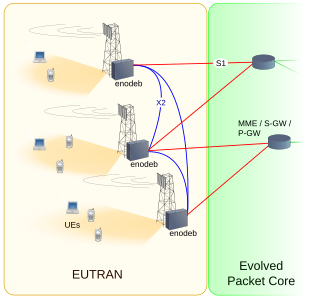
A wireless network is a computer network that uses wireless data connections between network nodes. Wireless networking allows homes, telecommunications networks, and business installations to avoid the costly process of introducing cables into a building, or as a connection between various equipment locations. Admin telecommunications networks are generally implemented and administered using radio communication. This implementation takes place at the physical level (layer) of the OSI model network structure.

Wireless community networks or wireless community projects or simply community networks, are non-centralized, self-managed and collaborative networks organized in a grassroots fashion by communities, non-governmental organizations and cooperatives in order to provide a viable alternative to municipal wireless networks for consumers.
Systems Network Architecture (SNA) is IBM's proprietary networking architecture, created in 1974. It is a complete protocol stack for interconnecting computers and their resources. SNA describes formats and protocols but, in itself, is not a piece of software. The implementation of SNA takes the form of various communications packages, most notably Virtual Telecommunications Access Method (VTAM), the mainframe software package for SNA communications.

Worldwide Interoperability for Microwave Access (WiMAX) is a family of wireless broadband communication standards based on the IEEE 802.16 set of standards, which provide physical layer (PHY) and media access control (MAC) options.

A cell site, cell phone tower, cell base tower, or cellular base station is a cellular-enabled mobile device site where antennas and electronic communications equipment are placed to create a cell, or adjacent cells, in a cellular network. The raised structure typically supports antenna and one or more sets of transmitter/receivers transceivers, digital signal processors, control electronics, a GPS receiver for timing, primary and backup electrical power sources, and sheltering.
A base transceiver station (BTS) or a baseband unit (BBU) is a piece of equipment that facilitates wireless communication between user equipment (UE) and a network. UEs are devices like mobile phones (handsets), WLL phones, computers with wireless Internet connectivity, or antennas mounted on buildings or telecommunication towers. The network can be that of any of the wireless communication technologies like GSM, CDMA, wireless local loop, Wi-Fi, WiMAX or other wide area network (WAN) technology.

A wireless mesh network (WMN) is a communications network made up of radio nodes organized in a mesh topology. It can also be a form of wireless ad hoc network.

A cellular network or mobile network is a telecommunications network where the link to and from end nodes is wireless and the network is distributed over land areas called cells, each served by at least one fixed-location transceiver. These base stations provide the cell with the network coverage which can be used for transmission of voice, data, and other types of content via radio waves. Each cell's coverage area is determined by factors such as the power of the transceiver, the terrain, and the frequency band being used. A cell typically uses a different set of frequencies from neighboring cells, to avoid interference and provide guaranteed service quality within each cell.
A cognitive radio (CR) is a radio that can be programmed and configured dynamically to use the best channels in its vicinity to avoid user interference and congestion. Such a radio automatically detects available channels, then accordingly changes its transmission or reception parameters to allow more concurrent wireless communications in a given band at one location. This process is a form of dynamic spectrum management.

E-UTRA is the air interface of 3rd Generation Partnership Project (3GPP) Long Term Evolution (LTE) upgrade path for mobile networks. It is an acronym for Evolved UMTS Terrestrial Radio Access, also known as the Evolved Universal Terrestrial Radio Access in early drafts of the 3GPP LTE specification. E-UTRAN is the combination of E-UTRA, user equipment (UE), and a Node B.
In a hierarchical telecommunications network, the backhaul portion of the network comprises the intermediate links between the core network, or backbone network, and the small subnetworks at the edge of the network.

Evolved High Speed Packet Access, HSPA+, HSPA (Plus) or HSPAP, is a technical standard for wireless broadband telecommunication. It is the second phase of HSPA which has been introduced in 3GPP release 7 and being further improved in later 3GPP releases. HSPA+ can achieve data rates of up to 42.2 Mbit/s. It introduces antenna array technologies such as beamforming and multiple-input multiple-output communications (MIMO). Beamforming focuses the transmitted power of an antenna in a beam toward the user's direction. MIMO uses multiple antennas on the sending and receiving side. Further releases of the standard have introduced dual carrier operation, i.e. the simultaneous use of two 5 MHz carriers. HSPA+ is an evolution of HSPA that upgrades the existing 3G network and provides a method for telecom operators to migrate towards 4G speeds that are more comparable to the initially available speeds of newer LTE networks without deploying a new radio interface. HSPA+ should not be confused with LTE though, which uses an air interface based on orthogonal frequency-division modulation and multiple access.
An Airborne Network (AN) is the infrastructure owned by the United States Air Force that provides communication transport services through at least one node that is on a platform capable of flight.
Gigabit Home Networking (G.hn) is a specification for wired home networking that supports speeds up to 2 Gbit/s and operates over four types of legacy wires: telephone wiring, coaxial cables, power lines and plastic optical fiber. Some benefits of a multi-wire standard are lower equipment development costs and lower deployment costs for service providers.

LTE Advanced is a mobile communication standard and a major enhancement of the Long Term Evolution (LTE) standard. It was formally submitted as a candidate 4G to ITU-T in late 2009 as meeting the requirements of the IMT-Advanced standard, and was standardized by the 3rd Generation Partnership Project (3GPP) in March 2011 as 3GPP Release 10.
A self-organizing network (SON) is an automation technology designed to make the planning, configuration, management, optimization and healing of mobile radio access networks simpler and faster. SON functionality and behavior has been defined and specified in generally accepted mobile industry recommendations produced by organizations such as 3GPP and the NGMN.

In telecommunications, 5G is the fifth generation of cellular network technology, which mobile operators began deploying worldwide in 2019 as the successor to 4G. 5G is based on standards defined by the International Telecommunication Union (ITU) under the IMT-2020 requirements, which outline performance targets for speed, latency, and connectivity to support advanced use cases.

Small cells are low-powered cellular radio access nodes that have a ranges of around 10 meters to a few kilometers. They are base stations with low power consumption and cost. They can provide high data rates by being deployed densely to achieve high spatial spectrum efficiency.
Multi-access edge computing (MEC), formerly mobile edge computing, is an ETSI-defined network architecture concept that enables cloud computing capabilities and an IT service environment at the edge of the cellular network and, more in general at the edge of any network. The basic idea behind MEC is that by running applications and performing related processing tasks closer to the cellular customer, network congestion is reduced and applications perform better. MEC technology is designed to be implemented at the cellular base stations or other edge nodes, and enables flexible and rapid deployment of new applications and services for customers. Combining elements of information technology and telecommunications networking, MEC also allows cellular operators to open their radio access network (RAN) to authorized third parties, such as application developers and content providers.
5G NR is a radio access technology (RAT) developed by the 3rd Generation Partnership Project (3GPP) for the 5G mobile network. It was designed to be the global standard for the air interface of 5G networks. It is based on orthogonal frequency-division multiplexing (OFDM), as is the 4G long-term evolution (LTE) standard.










